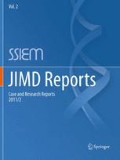Abstract
Congenital disorders of glycosylation (CDG) are an expanding group of genetic diseases affecting protein and lipid glycosylation. These disorders have a variable presentation and are individually rare. DPAGT1-CDG is a protein N-glycosylation disorder with epilepsy, development delay, severe hypotonia, and dysmorphy, reported in a single patient. Here we present the second family with DPAGT1-CDG identified through homozygosity mapping in a large consanguineous family with 18 affected infants. The patients had severe hypotonia, global developmental delay, seizures, and microcephaly but no dysmorphy. In the index case, the brain MRI revealed delayed myelination, and there was fiber type disproportion on muscle biopsy. Homozygosity mapping identified a large block of homozygosity on chromosome 11p15.5-q25 where two known CDG-I causing genes, ALG9 and DPAGT1, are located. Sequencing ALG9 did not reveal any mutations while analysis of DPAGT1 identified a novel homozygous mutation c.902G>A (p.R301H) in two affected infants. The disorder was fatal in all affected cases and mostly in early infancy.
Competing interests: None declared.
Access this chapter
Tax calculation will be finalised at checkout
Purchases are for personal use only
References
Clarke NF, North KN (2003) Congenital fiber type disproportion–30 years on. J Neuropathol Exp Neurol 62:977–989
Clarke NF, Kidson W, Quijano-Roy S et al (2006) SEPN1: associated with congenital fiber-type disproportion and insulin resistance. Ann Neurol 59:546–552
Clarke N, Kolski H, Dye D et al (2008) Mutations in TPM3 are a common cause of congenital fiber type disproportion. Ann Neurol 63:329–337
Freeze HH (2006) Genetic defects in the human glycome. Nat Rev Genet 7:537–551
Iso A, Murakami N, Yoneyama H, Hanaoka S, Kurokawa T, Nonaka I (1993) Idiopathic lactic acidemia with developmental delay and type 1 muscle fiber atrophy: report of two patients. Brain Dev 15:384–386
Jaeken J (2010) Congenital disorders of glycosylation. Ann NY Acad Sci 1214:190–198
Krendel DA, Shutter LA, Holt PJ (1994) Fiber type disproportion in metachromatic leukodystrophy. Muscle Nerve 17:1352–1353
Laing NG, Clarke NF, Dye DE et al (2004) Actin mutations are one cause of congenital fibre type disproportion. Ann Neurol 56:689–694
Marjanovic B, Cvetkovic D, Dozic S, Todorovic S, Djuric M (1996) Association of Krabbe leukodystrophy and congenital fiber type disproportion. Pediatr Neurol 15:79–82
Martin JJ, Clara R, Ceuterick C, Joris C (1976) Is congenital fiber type disproportion a true myopathy? Acta Neurol Belg 76:335–344
Miller SA, Dykes DD, Polesky HF (1988) A simple salting out procedure for extracting DNA from human nucleated cells. Nucleic Acids Res 16(3):1215
Ortolano S, Tarrío R, Blanco-Arias P et al (2011) A novel MYH7 mutation links congenital fiber type disproportion and myosin storage myopathy. Neuromuscul Disord 21(4):254–262
Shintani S, Shiigai T, Sugiyama N (1995) Atypical presentation of carnitine palmitoyltransferase (CPT) deficiency as status epilepticus. J Neurol Sci 129:69–73
Tachi N, Fujibayashi S, Wagatsuma K, Minami R, Imamura S (1984) A case of multiple sulfatase deficiency with fiber type disproportion. No To Hattatsu 16:205–209
Thiel C, Schwarz M, Peng J et al (2003) A new type of congenital disorders of glycosylation (CDG-Ii) provides new insights into the early steps of dolichol-linked oligosaccharide biosynthesis. J Biol Chem 278:22498–22505
Wilmshurst JM, Lillis S, Zhou H et al (2010) RYR1 mutations are a common cause of congenital myopathies with central nuclei. Ann Neurol 68(5):717–726
Woods CG, Cox J, Springell K et al (2006) Quantification of homozygosity in consanguineous individuals with autosomal recessive disease. Am J Hum Genet 78(5):889–896
Wu X, Rush JS, Karaoglu D et al (2003) Deficiency of UDP-GlcNAc:dolichol phosphate N-acetylglucosamine-1 phosphate transferase (DPAGT1) causes a novel congenital disorder of glycosylation type Ij. Hum Mutat 22:144–150
Acknowledgements
We thank members of the Saudi Diagnostics Laboratory sequencing core facility for technical assistance. This work reports findings identified during the course of routine molecular diagnostic services undertaken by the Research Centre of King Faisal Special Hospital and Research Centre.
Author information
Authors and Affiliations
Corresponding author
Editor information
Editors and Affiliations
Additional information
Communicated by: Jaak Jaeken.
Synopsis
Synopsis
Better understanding of the phenotype of DPAGT1-CDG (CDG-Ij) defect. Utilization of homozygosity mapping to identify the specific gene defect in consanguineous families suspected to have an undefined type of CDG.
Rights and permissions
Copyright information
© 2011 SSIEM and Springer-Verlag Berlin Heidelberg
About this chapter
Cite this chapter
Imtiaz, F., Al-Mostafa, A., Al-Hassnan, Z.N. (2011). Further Delineation of the Phenotype of Congenital Disorder of Glycosylation DPAGT1-CDG (CDG-Ij) Identified by Homozygosity Mapping. In: JIMD Reports - Case and Research Reports, 2011/2. JIMD Reports, vol 2. Springer, Berlin, Heidelberg. https://doi.org/10.1007/8904_2011_57
Download citation
DOI: https://doi.org/10.1007/8904_2011_57
Received:
Revised:
Accepted:
Published:
Publisher Name: Springer, Berlin, Heidelberg
Print ISBN: 978-3-642-24757-6
Online ISBN: 978-3-642-24758-3
eBook Packages: MedicineMedicine (R0)

